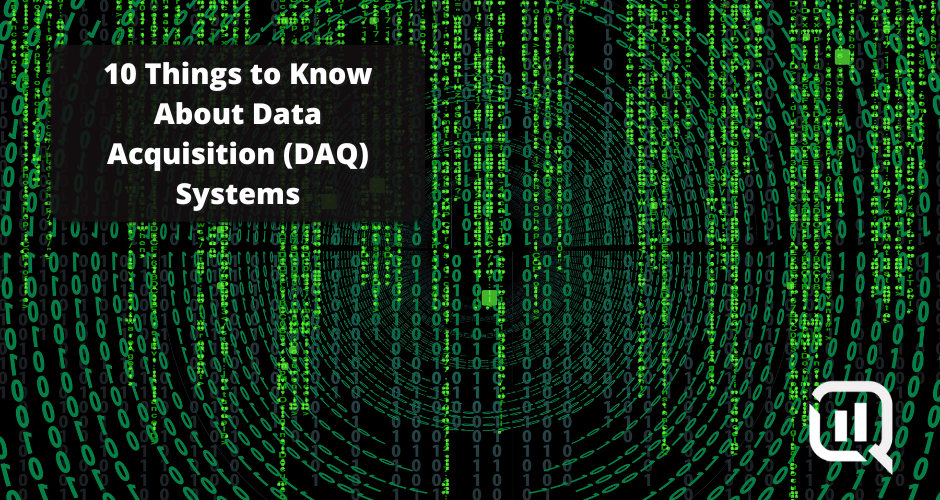In today’s data-driven world, data acquisition (DAQ) systems have become indispensable tools within a range of industries. These systems are designed to enable the collection, measurement, and analysis of valuable data, empowering businesses and organizations to make informed decisions, optimize processes, and gain a competitive edge.
Let’s explore the key aspects of DAQ systems and their significance in today’s data-driven world.
1. What is a Data Acquisition (DAQ) System?
A DAQ system is a combination of hardware and software used to collect, process, and store data from the physical world. It includes sensors, circuits, converters, storage, and communication interfaces. Its purpose is to convert real-world information into digital data for analysis.
2. Types of Data Acquisition (DAQ) Systems
There are various types of DAQ systems that cater to different application requirements. They can be categorized into hardware-based and software-based systems.
Hardware-based solutions involve dedicated devices that handle data acquisition tasks, while software-based systems use computers with specialized software for data acquisition purposes.
3️. Components
A DAQ system consists of multiple key components.
- Sensors or transducers convert physical parameters into electrical signals.
- Signal conditioning circuits amplify, filter, and process the electrical signals.
- Analog-to-digital converters (ADCs) convert analog signals into digital data.
- Data storage retains the acquired data.
- Communication interfaces facilitate data transfer to external devices or networks.
4️. Types of Data
DAQ systems have the capability to acquire various types of data. Analog signals, such as temperature and pressure measurements, can be captured. Digital signals, representing on/off states, can also be acquired. Furthermore, specialized data types like vibration or sound can be gathered using suitable sensors and transducers.
5. Applications
DAQ systems are used in various industries such as industrial automation, scientific research, environmental monitoring, automotive testing, and healthcare. They provide accurate and real-time data, which helps optimize processes, ensure quality control, and support decision-making.
6️. Sampling Rate and Resolution
Sampling rate and resolution are crucial parameters in DAQ systems. The sampling rate refers to the frequency at which data is measured and recorded, impacting the system’s ability to capture fast-changing signals. Resolution determines the smallest detectable change in the acquired signal. Higher sampling rates and resolutions result in more accurate data representation and finer measurement precision.
7️. Connectivity Options
DAQ systems offer diverse connectivity options to facilitate integration with computers, networks, and other devices. USB, Ethernet, Wi-Fi, and wireless protocols are commonly employed to establish connections. These options ensure seamless data transfer and accessibility across platforms.
8️. Software and Analysis
DAQ systems are complemented by software that offers the following features:
- Configuration and Control: Allows users to configure and control the data acquisition process.
- Data Analysis: Provides tools for analyzing acquired data, extracting valuable insights.
- Visualization: Enables users to visualize data through charts, graphs, and other visual representations.
- Data Logging: Allows for the logging and storage of acquired data for future reference and analysis.
- Post-processing: Offers capabilities for further processing and refining the acquired data.
- Advanced Analysis: Advanced software packages provide sophisticated analysis capabilities, unlocking deeper insights from the acquired data.
9️. Calibration and Accuracy
To maintain accuracy, DAQ systems require periodic calibration. Calibration involves comparing the system’s measurements against known reference values to ensure precise and reliable data acquisition. Regular calibration helps minimize errors and guarantees the accuracy of subsequent analyses.
10. Future Trends
DAQ systems are constantly evolving, fueled by emerging technologies. Here are some future trends in the field:
- Wireless and Remote Data Acquisition: Wireless capabilities enable flexible and convenient data collection, eliminating the constraints of wired connections.
- Integration with IoT Devices: Integrating with Internet of Things (IoT) devices expands connectivity options and broadens the scope of data acquisition, leveraging the power of interconnected devices.
- AI and ML Algorithm Application: The incorporation of artificial intelligence (AI) and machine learning (ML) algorithms empowers DAQ systems to perform advanced data analysis, uncover patterns, and make predictions for enhanced decision-making.
- Advanced Data Analysis and Predictive Modeling: With AI and ML algorithms, DAQ systems can unlock deeper insights from acquired data, enabling predictive modeling, anomaly detection, and optimization.
These trends showcase the exciting potential of DAQ systems as they embrace new technologies and drive innovation in data acquisition and analysis.
In Conclusion
Data acquisition systems are indispensable tools for collecting and analyzing data in various industries. They enable the conversion of physical phenomena into digital information, providing valuable insights for decision-making, process optimization, and quality control.
In today’s data-driven landscape, DAQ systems have become indispensable for industries seeking to harness the power of data. By effectively acquiring and analyzing data, businesses gain a competitive advantage and achieve better outcomes.
Contact QL2
To unlock the benefits of DAQ systems for your specific industry or application, consider working with QL2. With our cutting-edge DAQ solutions, we can provide you with tailored systems that meet your data acquisition needs and drive your business forward.
Explore the power of data acquisition and discover how QL2 can revolutionize your data collection and analysis processes. Get in touch with us today and embark on a data-driven journey towards success.
